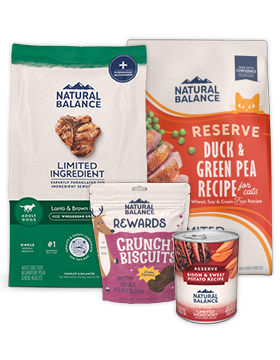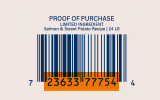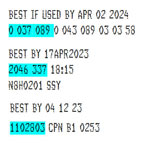
SATISFACTION GUARANTEED
True confidence begins with your complete satisfaction. If you ever have a question about one of our products, just reach out – we’re here to assist with expert service and advice.
Contact UsEvery batch of Natural Balance food and treats is rigorously tested to ensure the quality and safety of each bite.
Use the button below to chat with one of our Registered Veterinary Technicians.
Enter the Enter 10-digit UPC and 7-digit Lot Number (no spaces) from your package label. A member of our Registered Veterinary Technician team will send you the results of your food’s tests shortly. By clicking submit, I certify that I agree to receive future communications from Natural Balance.


UPC Example

Lot Number Example

We test for the most relevant food safety and quality parameters to ensure every batch of Natural Balance food meets our high quality standards. As part of our Feed with Confidence commitment, we test all applicable variables depending on the formula, which may include mycotoxins and/or pathogens. All formulas and recipes undergo a complete risk assessment by our quality and nutritional professionals. Depending on the formula and the ingredients used, mycotoxin testing may not be required. Mycotoxins can be present in grains and yeast ingredients, so if your food does not contain either of these ingredients, mycotoxin testing is not necessary.
Mycotoxins are naturally occurring toxins produced by fungi (molds). The class called aspergillus is of particular interest. There are several hundred types of aspergillus, 14 of which produce a harmful toxin called Aflatoxins (a Mycotoxin). Aflatoxin can be found on cereals (wheat, etc), oilseeds (peanuts, soybean, and sunflower) and tree nuts (pecans, pistachio, and walnuts). These fungi have a worldwide distribution and the incidence of contamination depends on many factors such as temperature, humidity and soil condition during growth and further on conditions during storage.
Vomitoxin (or DON, deoxynivalenol) is a mycotoxin derived from a fungus (mold) group called Fusarium, naturally present in soil and plants. Fusarium most often is present in grains such as wheat, barley, oats, and rye. This toxin causes severe gastrointestinal disease when ingested in sufficient amounts.
Escherichia coli (often abbreviated as E. coli) are a large and diverse group of bacteria. Although most strains of E. coli are harmless, others can cause serious food poisoning issues. We test for Shiga Toxin producing E. coli (STEC), which have been known to cause diarrhea with bloody stools, gastroenteritis, kidney failure and hemolytic anemia. In severe cases, infection with STEC organisms has led to irreversible injury to the gastrointestinal tract and death.
Fumonisin is a toxin produced by several species of the genus Fusarium Molds, which occur mainly in grains. Most species are harmless and are relatively abundant members of the soil microbial community. Some species produce mycotoxins in cereal crops that can affect human and animal health if they enter the food chain. While the acute toxicity of fumonisin is low, it is the known cause of two diseases which occur in domestic animals with rapid onset: equine leukoencephalomalacia and porcine pulmonary oedema syndrome.
Ochratoxins (A, B, C) are mycotoxins produced by some Aspergillus species and Penicillium species, like A. ochraceus or P. viridicatum, with ochratoxin A as the most prevalent and relevant fungal toxin of this group. Ochratoxin A is known to occur in commodities like cereal/grain, coffee, dried fruit and red wine. Ochratoxins may be toxic to humans as it collects in animal meat.
Salmonella spp. is a group of bacteria that have been known to be transmitted to humans or animals through contaminated foods. These organisms can cause illness such as diarrhea, sometimes with bloody stool, nausea, abdominal cramping and in more severe illnesses, urinary tract symptoms. While most people and animals recover with mild to moderate cases of Salmonellosis, hospitalization is often required with severe infections.
Zearalenone (ZEA) is a mycotoxin produced by some species of Fusarum and Gibberella Fungi (mold). Fusarium is a large genus of fungi widely distributed in soil and most species are harmless. However, some species produce mycotoxins in cereal crops, such as corn, barley, oats, wheat, rice, and sorghum, that can affect mammalian health.